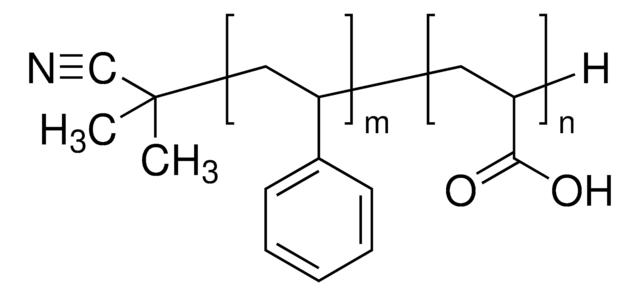746983
Poly(styrene)-block-poly(acrylic acid)
average Mn 38,000, 20 wt. % PAA, PDI ≤1.3
About This Item
Empfohlene Produkte
Form
powder
Mol-Gew.
Mn 27,000-33,000 (polystyrene)
Mn 34,000-42,000 (total)
Mn 7,000-9,000 (poly(acrylic acid))
average Mn 38,000
PDI
≤1.3
Suchen Sie nach ähnlichen Produkten? Aufrufen Leitfaden zum Produktvergleich
Anwendung
Rechtliche Hinweise
Sold for research purposes only. Not for use in humans. Before opening or using this product, please read the following terms and conditions. Use of this product shall constitute acknowledgement and acceptance of these terms and conditions.
Use of this product may be covered by one or more of the following US patents and corresponding claims outside the US: 7,714,075; 7,250,479; 7,666,962; 6,642,318; 6,747,111, and pending applications (W2010/8356). For details contact Aldrich Chemical Company, Inc.
Signalwort
Warning
H-Sätze
Gefahreneinstufungen
Eye Irrit. 2 - Skin Irrit. 2 - STOT SE 3
Zielorgane
Respiratory system
Lagerklassenschlüssel
11 - Combustible Solids
WGK
WGK 3
Flammpunkt (°F)
Not applicable
Flammpunkt (°C)
Not applicable
Analysenzertifikate (COA)
Suchen Sie nach Analysenzertifikate (COA), indem Sie die Lot-/Chargennummer des Produkts eingeben. Lot- und Chargennummern sind auf dem Produktetikett hinter den Wörtern ‘Lot’ oder ‘Batch’ (Lot oder Charge) zu finden.
Besitzen Sie dieses Produkt bereits?
In der Dokumentenbibliothek finden Sie die Dokumentation zu den Produkten, die Sie kürzlich erworben haben.
Artikel
Reversible addition–fragmentation chain transfer (RAFT) polymerization is rapidly moving to the forefront in construction of drug and gene delivery vehicles.
The development of drugs that target specific locations within the human body remains one of the greatest challenges in biomedicine today.
Over the past two decades, the rapid advance of controlled living polymerization (CLP) techniques.
Professor Robert K. Prud’homme introduces flash nanoprecipitation (FNP) for nanoparticle fabrication, which is a scalable, rapid mixing process for nanoparticle formulations.
Unser Team von Wissenschaftlern verfügt über Erfahrung in allen Forschungsbereichen einschließlich Life Science, Materialwissenschaften, chemischer Synthese, Chromatographie, Analytik und vielen mehr..
Setzen Sie sich mit dem technischen Dienst in Verbindung.









